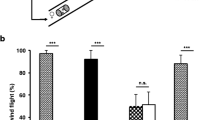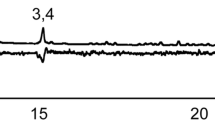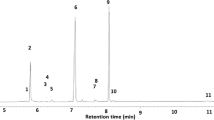Abstract
Whole body extracts of virgin Eurytoma amygdali females were attractive to males in laboratory bioassays. Extracts of various body parts of the female wasp elicited different responses to males, with the thorax extract being the most active. Preparative fractionation of the crude hydrocarbon extract on a silver nitrate impregnated silica gel column (alkanes, alkenes, and alkadienes) revealed that the highest male response was elicited by alkadienes and the lowest by alkenes, with the alkane fraction being inactive. The identification of alkenes and alkadienes was based on gas chromatographic, mass spectrometric, and gas-phase infrared data. Laboratory bioassays suggested that the two alkadienes, (Z,Z)-6,9-tricosadiene [(Z,Z)-6,9-C23:2], and (Z,Z)-6,9-pentacosadiene [(Z,Z)-6,9-C25:2], and to a lesser extent alkenes, identified in the female extract of E. amygdali were male attractants.
Similar content being viewed by others
REFERENCES
ARAMBOURG, Y., FAUVEL, F., and CHEVIN, H. 1983. Eurytoma amygdali End. et sa présence en France. Un nouveau chalcidien ravageur de l'amandier. Arboric. Fruti. 358:27–28.
ATTYGALLE, A. B., SVATOS, A., WILCOX, C., and VOERMAN, S. 1994. Gas-phase infrared spectroscopy for determination of double bond configuration of monounsaturated compounds. Anal. Chem. 66:1696–1703.
ATTYGALLE, A. B., SVATOS, A., WILCOX, C., and VOERMAN, S. 1995. Gas-phase infrared spectroscopy for determination of double-bond configuration of some polyunsaturated pheromones and related compounds. Anal. Chem. 67:1558–1567.
BIERL-LEONHARD, B. A., DEVILBISS, E. D., and PLIMMER, J. R. 1980. Location of double-bond position in long-chain aldehydes and acetates by mass spectral analysis of epoxide derivatives. J. Chromatogr. Sci. 18:364–367.
DESCOINS, C., LALANNECASSOU, B., MALOSSE, C, and MILAT, M. L. 1986. Analysis of the sexpheromone produced by the virgin female of Moscis-Latipes (Guenee), Noctuidae, Catocalinae, from Guadeloupe (French Antilla). C.R. Acad. Sci III 302:509–512.
DOUMENQ, P., GUILIANO, M., and MILLE, G. 1989. GC/FTIR potential for structural analysis of marine origin complex mixtures J. Environ. Anal. Chem. 37:235–244.
HOGGE, L. R., UNDERHILL, E.W., and WONG, J.W. 1985. The determination of position and geometry of unsaturation in multi-unsaturated aliphatic compounds by GC/MS. J. Chromatogr. Sci. 23:171–175.
KATSOYANNOS, B. I., KOULOUSSIS, N. A., and BASSILIOU, A. 1992. Monitoring populations of the almond seed wasp, Eyrytoma amygdali, with sex pheromone traps and other means, and optimal timing of chemical control. Entomol. Exp. Appl. 62:9–16.
LEAL, W. S. 1991. (R,Z )-5-(-)-(Oct-1-enyl)oxacyclopentan-2-one, the sex pheromone of the scarab beetle Anomala cuprea. Naturwissenschaften 78:521–523.
LEAL, W. S., MOURA, J. I. L., BENTO, J. M. S., VILELA, E. F., and PEREIRA, P. B. 1997. Electrophysiological and behavioral evidence for a sex pheromone in the wasp Bephratelloides pomorum. J. Chem. Ecol. 23:1281–1289.
MENTZELOS, J. and ATJEMIS, A. 1970. Studies on the biology and control of Eurytoma amygdali in Greece. 1970. J. Econ. Entomol. 63:1934–1936.
MONNIN, T., MALOSSE, C., and PEETERS, C. 1998. Solid-phase microextraction and cuticular hydrocarbon differences related to reproductive activity in queenless ant Dinoponera quadriceps. J. Chem. Ecol. 24:473–490.
PAGE, M., NELSON, L. J., BLOMQUIST, G. J., and SEYBOLD, S. J. 1997. Cuticular hydrocarbons as chemotaxonomic characters of pine engraver beetles (Ips spp.) in the grandicollis subgeneric group. J. Chem. Ecol. 23:1053–1099.
PITTARA, I. S. and KATSOYANNOS, B. I. 1985. Male attraction to virgin females in the almond seed wasp, Eurytoma amygdali Enderlein (Hymenoptera, Eyrytomidae). Entomol. Hell. 3:43–46.
PLAUT, H. N. 1971. On the biology of the adult of the almond seed wasp, Eyrytoma amygdali End. (Hym., Eyrytomidae) in Israel. Bull. Entomol. Res. 61:275–281.
PLAUT, H. N. 1972. On the biology of the immature stages of the almond seedwasp, Eurytoma amygdali End. (Hym., Eyrytomidae) in Israel. Bull. Entomol. Res. 61:681–687.
SLEDGE, M. F., MONETI, G., PIERACCINI, G., and TURILLAZZI, S. 2000. Use of solid-phase microextraction in the investigation of chemical communication in social wasps. J. Chromatogr. 873:73–77.
SYVERTSEN, T. C., JACKSON, L. L., BLOMQUIST, G. L., and VINSON, S. B. 1995. Alkadienes mediating courtship in the parasitoid Cardiochiles nigriceps (Hymenoptera:Braconidae). J. Chem. Ecol. 21:1971–1989.
TALHOUK, A. S. 1977. Contributions to the knowledge of almond pests in East Mediterranean countries. V. The fruit-feeding insects, Eurytoma amygdali End., and Arnasia lineatella Z. Z. Angew. Entomol. 83:145–154.
TURILLAZZI, S., SLEDGE, M. F., and MONETI, G. 1998. Use of a simple method for sampling cuticular hydrocarbons from live social wasps. Ethol. Ecol. Evolt. 10:293–297.
ZEROVA, M. D. and FURSOV, V. N. 1991. The palearctic species of Eurytoma (Hymenoptera: Eurytomidae) developing in stone fruits (Rosaceae: Prunoideae). Bull. Entomol. Res. 81:209–219.
Author information
Authors and Affiliations
Rights and permissions
About this article
Cite this article
Krokos, F.D., Konstantopoulou, M.A. & Mazomenos, B.E. Alkadienes and Alkenes, Sex Pheromone Components of the Almond Seed Wasp Eurytoma amygdali. J Chem Ecol 27, 2169–2181 (2001). https://doi.org/10.1023/A:1012218618218
Issue Date:
DOI: https://doi.org/10.1023/A:1012218618218




